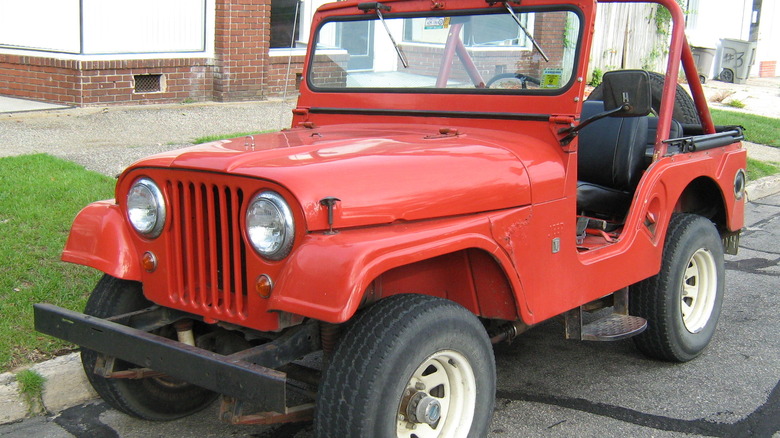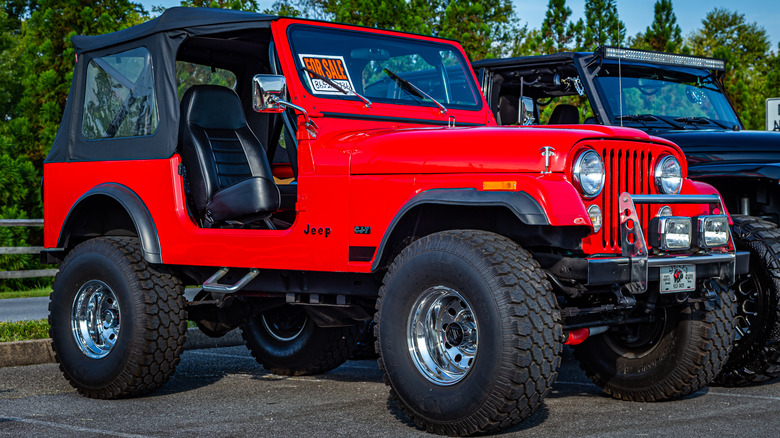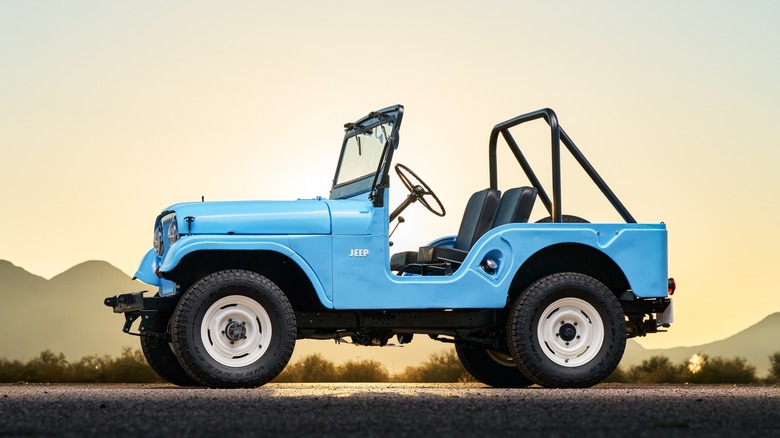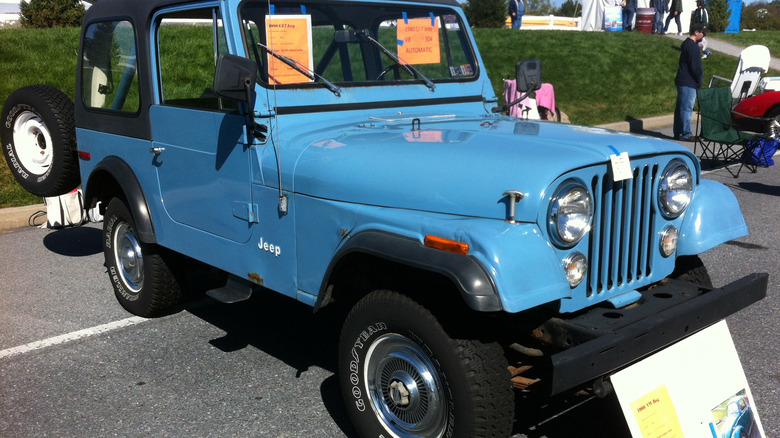Jeep CJ5 Vs CJ7: What's The Difference?
The Jeep CJ was the brand's civilian version of the Quad Willys Overland built for the U.S. Army during World War II. The CJ-2A went on sale in 1945, and the CJ-3A and CJ-3B followed within a decade. The line's production skipped the number four, although a single CJ-4 prototype was manufactured around 1950 and sold to an employee. Henry Kaiser bought Willys in 1953, and two years later the CJ-5's 29-year run began. American Motors Corporation (AMC) purchased Jeep from Kaiser in 1970, and kept the CJ-5 in the lineup until 1983. Meanwhile, seven years earlier, the CJ-7 entered the equation. The CJ-7 was in production through 1986, yielding to the first of four generations of the Wrangler when Chrysler purchased Jeep in 1987.
At first glance, these two off-road beasts appear almost identical, but there are some clear distinctions between the CJ-5 and CJ-7 (aside from the length of their production runs). That is a good place to start, though: The CJ-5's 29 years in production are the most of any Jeep in history and helped land it a spot on our list of Jeep's best dozen models ever.
[Featured image by CZMarlin via Wikimedia Commons|Cropped and scaled|Public Domain]
The CJ-7 is longer than the CJ-5
Both constitute old Jeeps you'll want to bring back to glory. The CJ-5 and CJ-7 share a basic stubby, two-door, open-top body style, but you can tell them apart quickly by looking at the door openings. The CJ-7's door sills are straight horizontal lines, while the CJ-5's have a short horizontal run ahead of an upward curve just ahead of the rear wheel cutouts. If you take out a tape measure, you can mark the difference in size too. The CJ-7's wheelbase is 93.5 inches, while the CJ-5 stands 81 inches from hub to hub through 1981 and 83.5 inches after. With the extended frame came a wider rear section that made room for a broader axle and gave the CJ-7 a more sure-footed stance than the CJ-5.
The additional space in the CJ-7 was in the footwells and cargo area, making the ride more comfortable for taller folks and leaving more room for the rear seat and cargo. The factory hard top on CJ-5s was an unwieldy piece of steel, while the CJ-7 got a new injection-molded plastic top that could be easily removed or replaced by two people, or solo if you have a strong back.
Only the CJ-7 had an automatic transmission
The most important change that came along with the CJ-7's debut was the introduction of an automatic transmission, which had previously been limited to Jeep's enclosed SUVs like the Cherokee and Wagoneer. The CJ-5 never offered an automatic, nor was it ever issued with Jeep's QuadraTrac full-time all-wheel drive system like the 1976 to '79 CJ-7. The CJ-5's doors were bare metal, while the CJ-7's had interior padding, which provided some insulation from the cold. These are the basic differences between the CJ-5 and CJ-7, but there were many variations among their engines, transmissions, and axles.
The CJ-5 started with the Hurricane F-head four-cylinder and Buick Dauntless 225 cubic inch V6, and got a 304 cubic inch V8 starting in 1972. AMC started using an 82-hp version of GM's wholly uninspiring Iron Duke I4 in CJ5s in 1980 but dumped it as the base engine three years later. Borg-Warner supplied at least a half-dozen three- and four-speed manuals for the CJ-5, but we won't dull your senses by listing them all. Three different Dana transfer cases were used behind those gearboxes: at first the Model 18, then the Model 20 from 1972-1979, and the Model 300 from 1980 through the end of the CJ-5's run in 1983. A Dana 44 axle went in the back, and the front rotated from a Dana 25 to a model 27 in 1966 and a full-float Dana 30 in 1972.
The CJ-7 had five different engines
The CJ-7 originally came with 232 and 258 straight sixes, with the 304 V8 as an option. The 232 was dropped in 1979, but the next year the Iron Duke was back as the CJ-7's base engine. The V8 was dropped in 1982, and AMC's notoriously reliable 2.5 liter I4 replaced the Iron Duke in 1984. The 2.5 liter four and 258 I6 remained the only CJ7 engine choices through the end of its run. From 1976 to 1979, a three-speed Tremec T150 and four-speed Borg-Warner T18 were the manual transmission choices, and Quadratrac and other automatic CJ-7s got an AMC version of GM's TH-400.
The CJ-7's transmissions got a refresh in 1980. Behind the Iron Duke I4 sat a Borg-Warner SR-4 manual or a Torqueflite 904 automatic, and I6 CJ7s got the Tremec T-176 stick or Torqueflite 999 auto. From 1982 through 1986, Borg-Warner T4 and T5 manuals replaced the SR-4, and the TF999 hung on as the automatic option. Through 1979, the part-time transfer case was a Dana 20 and Quadratrac versions got a Borg-Warner 1339. '80s CJ-7s had the stout Dana 300. Most CJ-7s inherited the Dana 30 front and Dana 20 rear axles from the CJ-5, but some lucky 1986 buyers got a Dana 44 in the back. We suggest printing this article out and using it as a reference when shopping for CJs, it should help you tell if major components have been swapped out.
[Featured Image by CZMarlin via Wikimedia Commons|Cropped and scaled|CC-By 1.0]



